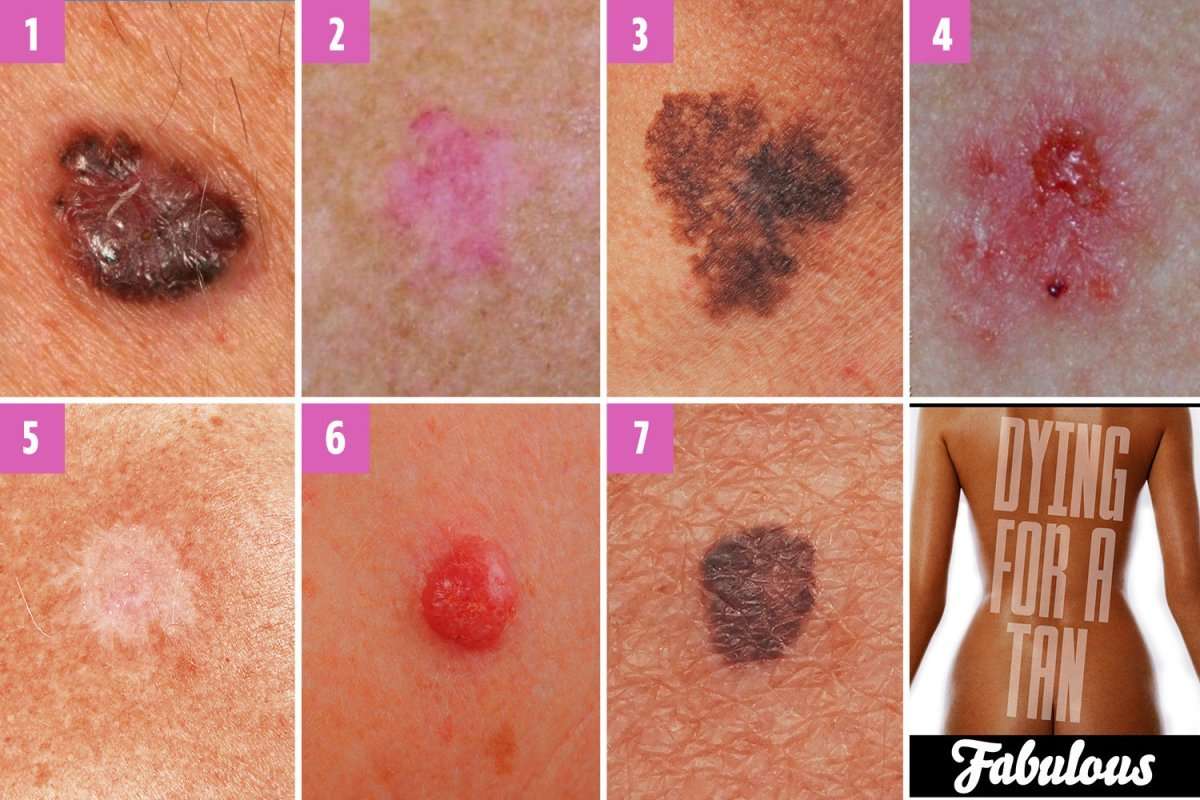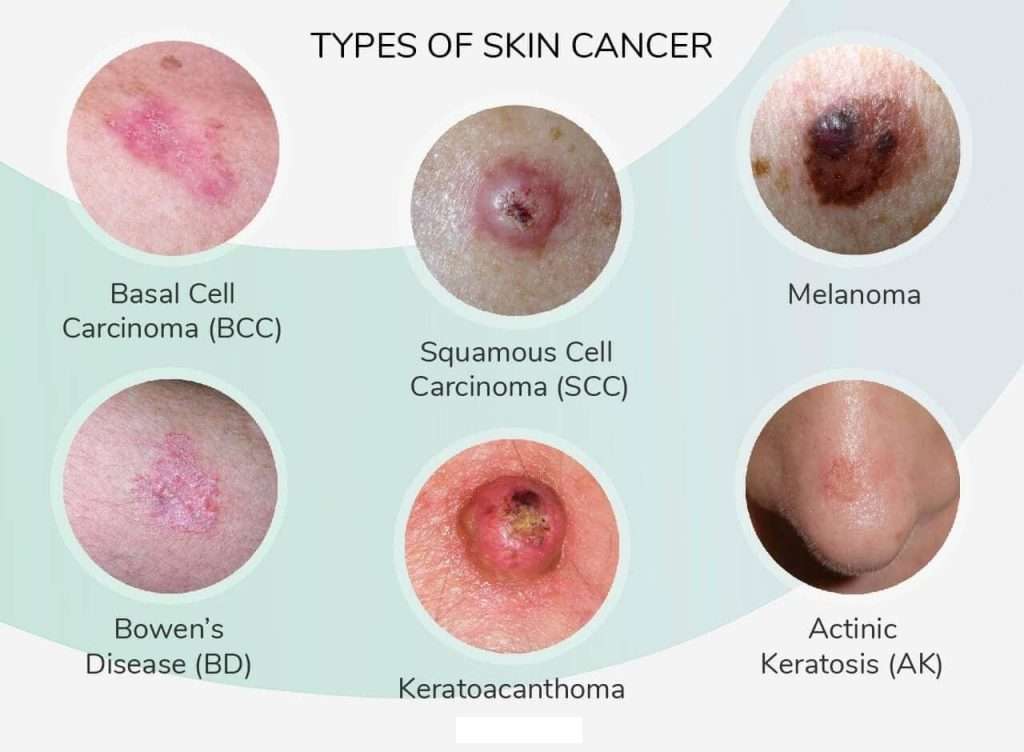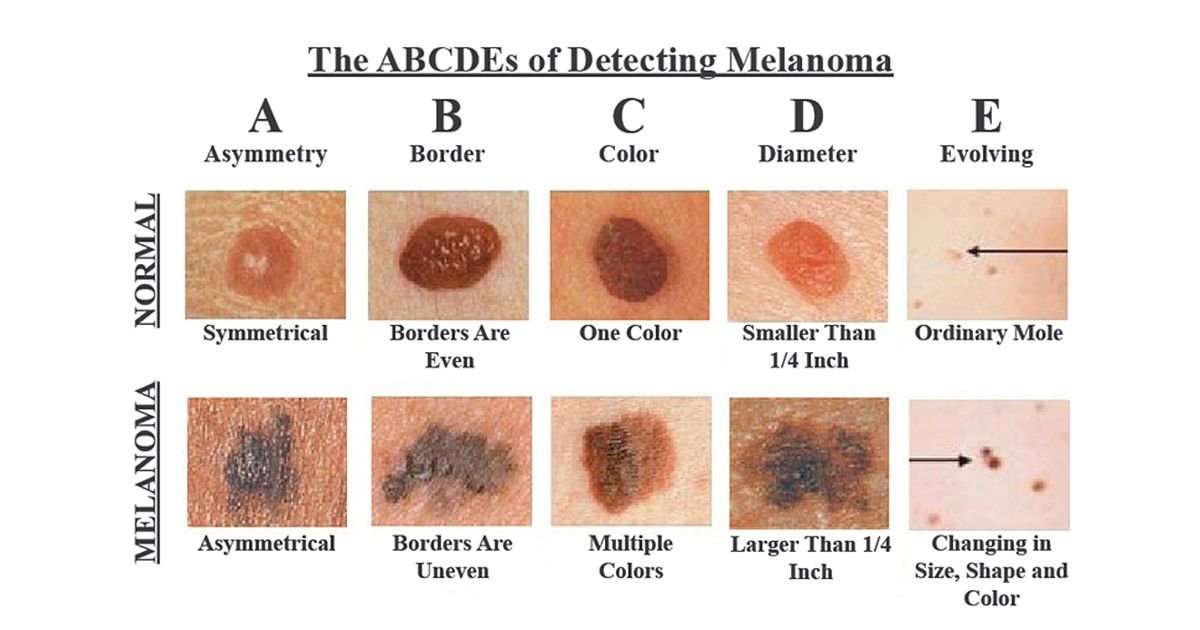Skin Cancer Warning Signs
The main symptom of skin cancer is a mole or other growth on your skin. To find these growths, you need to look for them. Some doctors recommend that you do a full-body self-exam in front of a mirror once a month.
Most skin cancers develop in sun-exposed areas like your face, scalp, chest, arms, and legs so its important to check these areas.
Its also a good idea to check places that are rarely exposed, such as your palms, genitals, your fingernails and toenails, and the soles of your feet.
How Do You Treat Skin Cancer On The Nose
The nose is a relatively common spot for skin cancer to develop. Skin cancer often starts on the face because it’s usually the body part that’s exposed to the sun. The two most common types of skin cancer that develop on the nose are basal cell carcinoma and squamous cell carcinoma . While both types of skin cancer should be addressed right away, BCC is usually slow-growing and SCC grows more quickly. Basal cell carcinoma is the most common type of skin cancer ,with about 80% of cases occurring on the face and 25 to 30% on the nose.
The third type of skin cancer, melanoma, is rare and much more serious. It almost always requires excisional surgery to remove it. Fortunately, most forms of skin cancer are very treatable, especially when caught early. Treatment may include surgery, radiation, topical treatments, and more.
Taking Care Of Yourself
After you’ve been treated for basal cell carcinoma, you’ll need to take some steps to lower your chance of getting cancer again.
Check your skin. Keep an eye out for new growths. Some signs of cancer include areas of skin that are growing, changing, or bleeding. Check your skin regularly with a hand-held mirror and a full-length mirror so that you can get a good view of all parts of your body.
Avoid too much sun. Stay out of sunlight between 10 a.m. and 2 p.m., when the sun’s UVB burning rays are strongest.
Use sunscreen. The suns UVA rays are present all day long — thats why you need daily sunscreen. Make sure you apply sunscreen with at least a 6% zinc oxide and a sun protection factor of 30 to all parts of the skin that aren’t covered up with clothes every day. You also need to reapply it every 60 to 80 minutes when outside.
Dress right. Wear a broad-brimmed hat and cover up as much as possible, such as long-sleeved shirts and long pants.
Continued
Recommended Reading: Invasive Breast Cancer Survival Rate
How To Spot An Scc
SCC of the skin can develop anywhere on the body but is most often found on exposed areas exposed to ultraviolet radiation like the face, lips, ears, scalp, shoulders, neck, back of the hands and forearms. SCCs can develop in scars, skin sores and other areas of skin injury. The skin around them typically shows signs of sun damage such as wrinkling, pigment changes and loss of elasticity.
SCCs can appear as thick, rough, scaly patches that may crust or bleed. They can also resemble warts, or open sores that dont completely heal. Sometimes SCCs show up as growths that are raised at the edges with a lower area in the center that may bleed or itch.
Melanoma Signs And Symptoms

Melanoma skin cancer is much more serious than basal cell carcinoma and squamous cell carcinoma. It can spread quickly to other organs and causes the vast majority of skin cancer deaths in the United States. Usually melanomas develop in or around an existing mole.
Appearance
Signs and symptoms of melanoma vary depending on the exact type and may include:
- A flat or slightly raised, discolored patch with irregular borders and possible areas of tan, brown, black, red, blue or white
- A firm bump, often black but occasionally blue, gray, white, brown, tan, red or your usual skin tone
- A flat or slightly raised mottled tan, brown or dark brown discoloration
- A black or brown discoloration, usually under the nails, on the palms or on the soles of the feet
See more pictures and get details about different types of melanoma in our dedicated melanoma section.
Read Also: Cancer All Over Body Symptoms
Tips For Screening Moles For Cancer
Examine your skin on a regular basis. A common location for melanoma in men is on the back, and in women, the lower leg. But check your entire body for moles or suspicious spots once a month. Start at your head and work your way down. Check the “hidden” areas: between fingers and toes, the groin, soles of the feet, the backs of the knees. Check your scalp and neck for moles. Use a handheld mirror or ask a family member to help you look at these areas. Be especially suspicious of a new mole. Take a photo of moles and date it to help you monitor them for change. Pay special attention to moles if you’re a teen, pregnant, or going through menopause, times when your hormones may be surging.
You Can Find Skin Cancer On Your Body
The best way to find skin cancer is to examine yourself. When checking, you want to look at the spots on your skin. And you want to check everywhere from your scalp to the spaces between your toes and the bottoms of your feet.
If possible, having a partner can be helpful. Your partner can examine hard-to-see areas like your scalp and back.
Getting in the habit of checking your skin will help you notice changes. Checking monthly can be beneficial. If you have had skin cancer, your dermatologist can tell you how often you should check your skin.
People of all ages get skin cancer
Checking your skin can help you find skin cancer early when its highly treatable.
Read Also: Lobular Breast Cancer Survival Rate
What Skin Cancer Looks Like
Skin cancer appears on the body in many different ways. It can look like a:
-
Changing mole or mole that looks different from your others
-
Dome-shaped growth
-
Non-healing sore or sore that heals and returns
-
Brown or black streak under a nail
It can also show up in other ways.
To find skin cancer on your body, you dont have to remember a long list. Dermatologists sum it up this way. Its time to see a dermatologist if you notice a spot on your skin that:
-
Differs from the others
-
Itches
-
Bleeds
To make it easy for you to check your skin, the AAD created the Body Mole Map. Youll find everything you need to know on a single page. Illustrations show you how to examine your skin and what to look for. Theres even place to record what your spots look like. Youll find this page, which you can print, at Body Mole Map.
Dry Flaky Skin On Nose
Focusing on the dry flaky skin on your nose, it can show up as dry scales, blisters that crust over, skin peeling, sores, ashy patches, white dots, and marks. Also, the flaky skin on the nose can be rough and sometimes leathery.
For more emphasis, your face might develop dry flaky skin due to causes that are already been discussed in the relevant section of the post. These causes include contact dermatitis, environmental conditions, smoking, excess alcohol, certain medication and skin infection such as eczema, cancer, psoriasis, and rosacea.
Also Check: What Is The Survival Rate For Invasive Ductal Carcinoma
Don’t Miss: Invasive Ductal Carcinoma Survival Rate Stage 4
What Are The Signs And Symptoms Of Basal Cell Carcinoma
Basal cell carcinoma is a type of skin cancer that can show up on the skin in many ways. Also known as BCC, this skin cancer tends to grow slowly and can be mistaken for a harmless pimple, scar, or sore.
Common signs and symptoms of basal cell carcinoma
This skin cancer often develops on the head or neck and looks like a shiny, raised, and round growth.
To help you spot BCC before it grows deep into your skin, dermatologists share these 7 warning signs that could be easily missed.
If you find any of the following signs on your skin, see a board-certified dermatologist.
Looking For Signs Of Skin Cancer
Non melanoma skin cancers tend to develop most often on skin that’s exposed to the sun.
To spot skin cancers early it helps to know how your skin normally looks. That way, you’ll notice any changes more easily.
To look at areas you cant see easily, you could try using a hand held mirror and reflect your skin onto another mirror. Or you could get your partner or a friend to look. This is very important if you’re regularly outside in the sun for work or leisure.
You can take a photo of anything that doesn’t look quite right. If you can it’s a good idea to put a ruler or tape measure next to the abnormal area when you take the photo. This gives you a more accurate idea about its size and can help you tell if it’s changing. You can then show these pictures to your doctor.
You May Like: Whats Cancer Look Like
A Word About Reconstruction
The different techniques used in treating skin cancers can be life saving, but they may leave a patient with less than pleasing cosmetic or functional results. Depending on the location and severity of the cancer, the consequences may range from a small but unsightly scar to permanent changes in facial structures such as your nose, ear, or lip.
In such cases, no matter who performs the initial treatment, the plastic surgeon can be an important part of the treatment team. Reconstructive techniques- ranging from a simple scar revision to a complex transfer of tissue flaps from elsewhere on the body-can often repair damaged tissue, rebuild body parts, and restore most patients to acceptable appearance and function.
Recommended Reading: Can Skin Cancer Be Cured With Cream
Start Your Care With A Fellowship

This may seem like a no-brainer, but when it comes to skin cancer treatment, youre better off beginning your care with a board-certified dermatologist. Choosing a dermatologist with fellowship training in skin oncology and dermatologic surgery is also important.
Sometimes people go right to a plastic surgeon when they have something on their face, Dr. Lee explains. But skin cancer can grow wider than anticipated, making complete removal tricky.
One way to ensure that you get the best cosmetic outcome is to seek out a dermatologist with experience in treating facial skin cancer. Dermatologists who have completed a dermatologic surgery fellowship tend to have the most experience with facial cancers, Dr. Lee says. Ask your dermatologist for a referral to a dermatologic surgeon or seek treatment at a medical center with dermatologic surgeons on staff.
Fellowship-trained dermatologic surgeons are experts in delicate skin-sparing procedures that can better preserve your appearance while also making sure that all of the cancer is removed. They are also skilled in reading pathology, Dr. Lee points out, which gives them an excellent understanding of how cancer grows so they can ensure that they are removing all of it.
And if you do need a plastic surgeon, a dermatologic surgeon will be able to advise you.
Also Check: How Long Does It Take For Melanoma To Spread To Organs
The Cosmetic Effects Of Mohs Surgery On The Nose
Mohs surgery, while effective, is not always the best option for treating skin cancer on the nose. Because Mohs requires a doctor to surgically remove multiple layers of skin from the cancerous spot, patients will be left with a wound when the treatment is over. Once the wound heals, there will likely be a scar. Depending on the size of the wound, some patients may even need to have a skin graft or undergo reconstructive surgery to heal.
What Is My Skin Type
Skin types that are more sensitive to ultraviolet radiation burn more quickly and are at a greater risk of skin cancer.
All skin types can be damaged by too much UV radiation. Skin types that are more sensitive to UV radiation burn more quickly and are at a greater risk of skin cancer.
People with naturally very dark skin still need to take care in the sun even though they may rarely, if ever, get sunburnt. The larger amount of melanin in very dark skin provides natural protection from UV radiation. This means the risk of skin cancer is lower.
Eye damage can occur regardless of skin type. High levels of UV radiation have also been linked to harmful effects on the immune system.
Vitamin D deficiency may be a greater health concern for people with naturally very dark skin, as it is more difficult for people with this skin type to make vitamin D.
Read Also: What Is Squamous Cell Carcinoma Of The Head And Neck
Are Some People Just Naturally Good Healers
Having a good blood supply to the area of the surgery is the number one issue in healing, says Dr. Khorasani. In general, when youre younger, you have a greater blood supply, so younger people tend to heal well. However, he says he has seen many elderly patients who naturally heal well, too. I think that just means they have good regenerative machinery. I always ask them what their secret is, especially those over 90 who are super sharp mentally. Some people are just genetically blessed and heal really well like Wolverine!
See A Suspicious Spot See A Dermatologist
If you find a spot on your skin that could be skin cancer, its time to see a dermatologist. Found early, skin cancer is highly treatable. Often a dermatologist can treat an early skin cancer by removing the cancer and a bit of normal-looking skin.
Given time to grow, treatment for skin cancer becomes more difficult.
Recommended Reading: Immunotherapy For Malignant Melanoma
A Simple Way To Control Shine
When the stubborn oil on your nose wont go away, it can be difficult to resist the urge to over-treat it with harsh spot treatments. However, treating your oily nose with Benzoyl Peroxide and other harsh ingredients will likely just make the problem worse.
Instead, treat your oily nose with a gentle skin care system that will control oil production without drying out your skin. If you havent tried Tiege Hanley yet, give it a test run and let us know what you think!
You May Like: How Long Does It Take Melanoma To Metastasize
What To Do If You Notice Skin Changes
If you notice anything unusual on your skin, make an appointment to show it to your GP. It might help to take a photograph of anything unusual, so you can check for any changes. Remember there are many other skin conditions that are not cancer, especially in older people.
It can be more difficult to notice changes if you have darker skin. This is because symptoms of skin cancer may be less obvious than in people with paler skin. If you notice any changes, such as a sore that does not heal, always see your GP.
Macmillan is here to support you. If you would like to talk, you can:
Read Also: Invasive Ductal Carcinoma Grade 3 Life Expectancy
How Do People Find Bcc On Their Skin
Many people find it when they notice a spot, lump, or scaly patch on their skin that is growing or feels different from the rest of their skin. If you notice any spot on your skin that is growing, bleeding, or changing in any way, see a board-certified dermatologist. These doctors have the most training and experience in diagnosing skin cancer.
To find skin cancer early, dermatologists recommend that everyone check their own skin with a skin self-exam. This is especially important for people who have a higher risk of developing BCC. Youll find out what can increase your risk of getting this skin cancer at, Basal cell carcinoma: Who gets and causes.
Images used with permission of:
-
The American Academy of Dermatology National Library of Dermatologic Teaching Slides.
-
J Am Acad Dermatol. 2019 80:303-17.
Warning Signs Of Basal Cell Carcinoma That You Could Mistake As Harmless

Warning sign: A pink or reddish growth that dips in the centerCan be mistaken for: A skin injury or acne scar
A pink or reddish growth that dips in the center
The BCC on this patients cheek could be mistaken for a minor skin injury.
Warning sign: A growth or scaly patch of skin on or near the earCan be mistaken for: Scaly, dry skin, minor injury, or scar
A growth or scaly patch of skin on or near the ear
BCC often develops on or near an ear, and this one could be mistaken for a minor skin injury.
Warning sign: A sore that doesn’t heal and may bleed, ooze, or crust overCan be mistaken for: Sore or pimple
A sore that doesn’t heal, or heals and returns
This patient mistook the BCC on his nose for a non-healing pimple.
Warning sign: A scaly, slightly raised patch of irritated skin, which could be red, pink, or another colorCan be mistaken for: Dry, irritated skin, especially if it’s red or pink
A scaly, slightly raised patch of irritated skin
This BCC could be mistaken for a patch of dry, irritated skin.
Warning sign: A round growth that may be pink, red, brown, black, tan, or the same color as your skinCan be mistaken for: A mole, wart, or other harmless growth.
A round growth that may be same color as your skin
Would you recognize this as a skin cancer, or would you dismiss it as a harmless growth on your face?
You May Like: Stage 3 Melanoma Life Expectancy